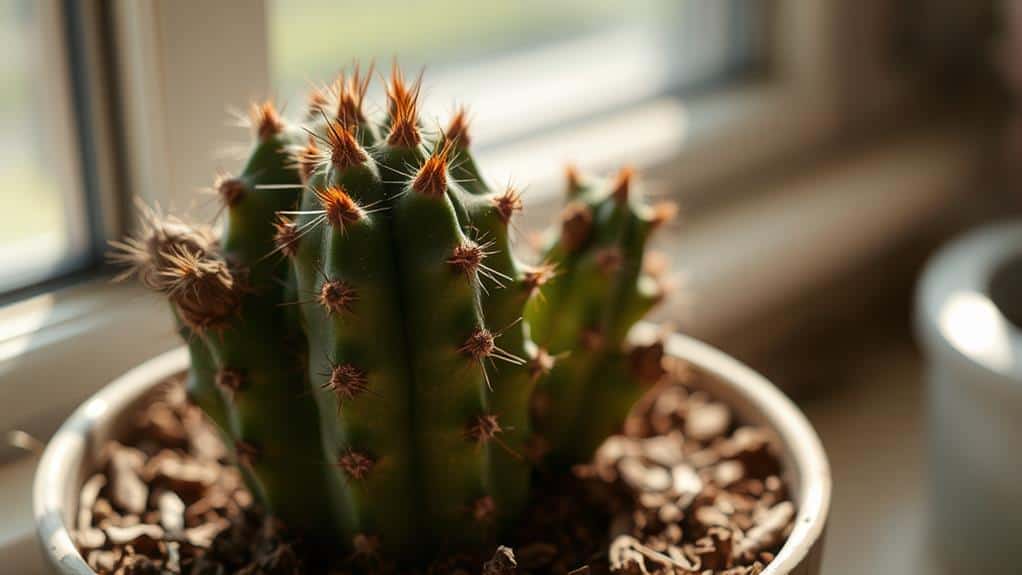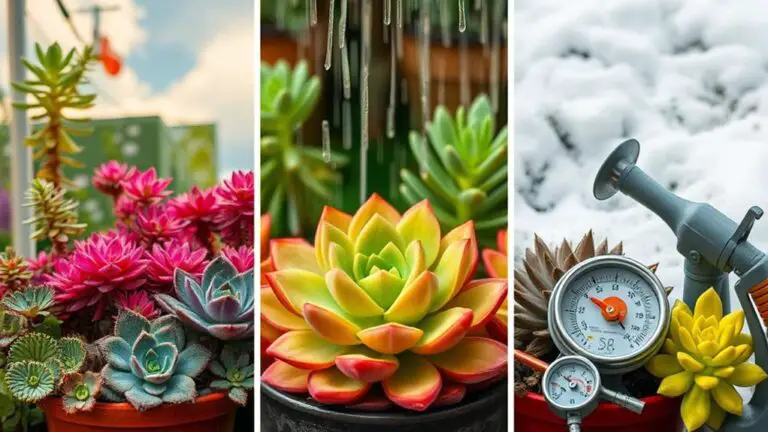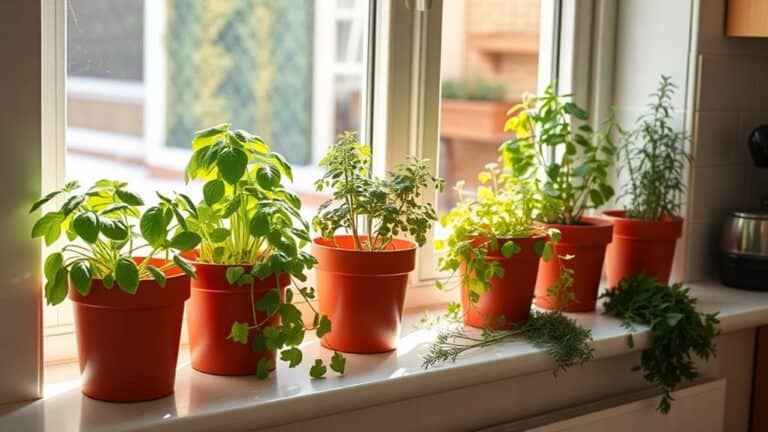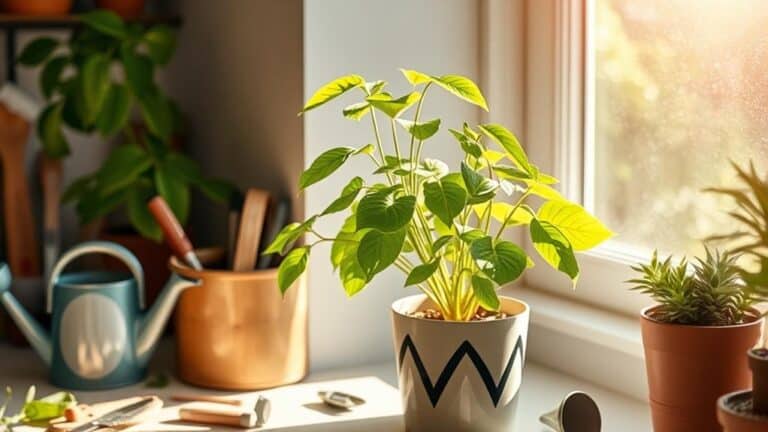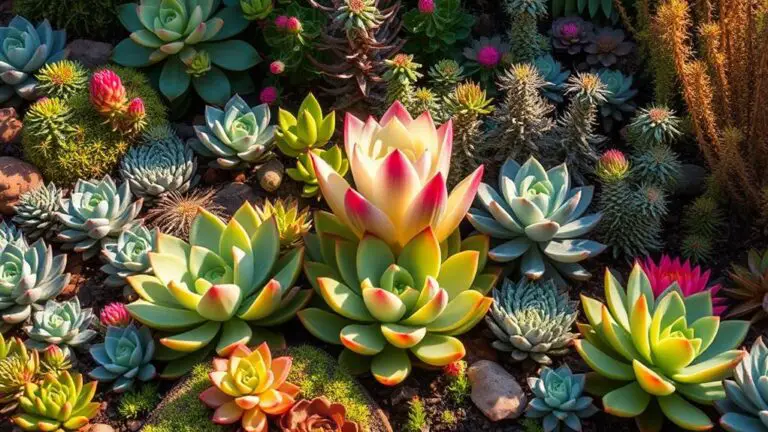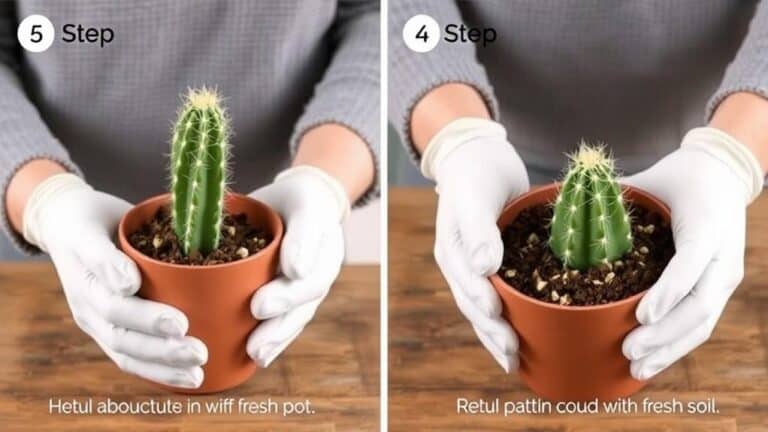Why Is My Cactus Turning Brown?
If your cactus is turning brown, you might be puzzled about what's causing it. Overwatering is often the main culprit, leading to root rot and mushy tissue. However, there's more to take into account—seasonal care, soil quality, physical damage, and even pest infestations could be at play. Fungal diseases might show up as brown or black spots, and natural aging, known as corking, is usually harmless. So, how do you pinpoint the exact issue and guarantee your cactus thrives? Let's explore some practical steps to diagnose and remedy these problems effectively.
Overwatering Issues
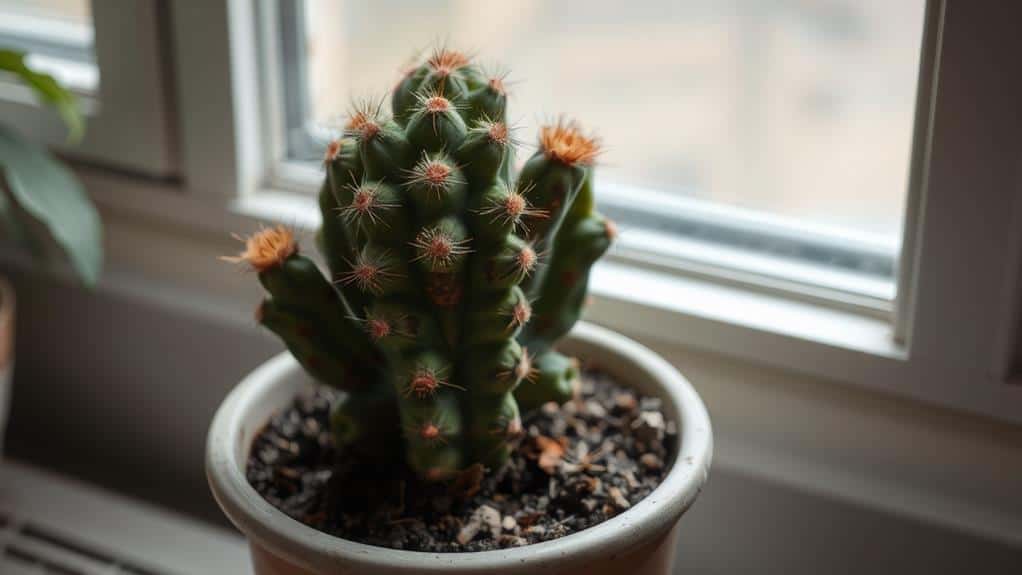
Overwatering is the leading cause of your cactus turning brown, often leading to root rot. When this happens, you'll notice yellow-brown discoloration and a mushy texture in the affected areas.
To prevent this, it's vital to only water your cactus when the soil has dried out about 4-5 cm deep. This mimics the cactus's natural arid environment and helps manage moisture levels.
Using well-draining potting soil specifically designed for cacti can also help. This type of soil allows excess water to escape and promotes proper aeration, which is essential for your plant's health.
If you see black spots on your cactus, or if the tissue starts to soften, these are clear signs of overwatering. In severe cases, your cactus may even start to tip over, indicating that its health is considerably compromised.
To combat overwatering, stop watering immediately. If necessary, transplant your cactus into dry, well-draining soil to help it recover.
Taking these steps can save your cactus from further damage and get it back to a healthy state. Remember, less water is often better when caring for cacti.
Seasonal Care
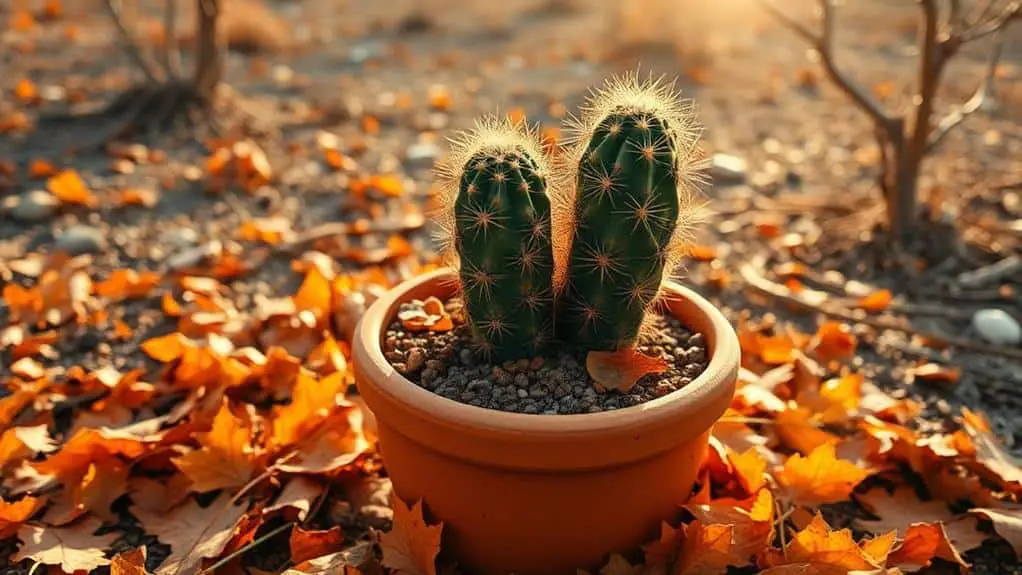
Adjusting your cactus care seasonally is vital for its overall health and preventing browning. During summer, cacti are in their active growth phase, needing more frequent watering. However, in winter, they enter dormancy and require minimal watering.
Here's how you can keep your cactus happy and healthy through the seasons:
- Watering Frequency: Increase watering in summer and reduce it greatly in winter.
- Temperature Adjustments: Adjust watering based on room temperature and light exposure.
- Sunlight Needs: Confirm your cactus gets the right amount of sunlight, as seasonal changes affect growth patterns.
- Soil Moisture Monitoring: Regularly check the soil, letting it dry out 4-5 cm deep between waterings, especially in the growing season.
- Species-Specific Care: Understand the specific seasonal needs of your cactus species to prevent browning.
Sudden changes in care routines can lead to your cactus turning brown, so stay observant.
By monitoring and adjusting your cactus care throughout the year, you can confirm it thrives.
Remember, a little extra attention to seasonal care can make a big difference in keeping your cactus vibrant and healthy.
Stick to these tips, and your cactus will reward you with its beauty.
Soil Quality
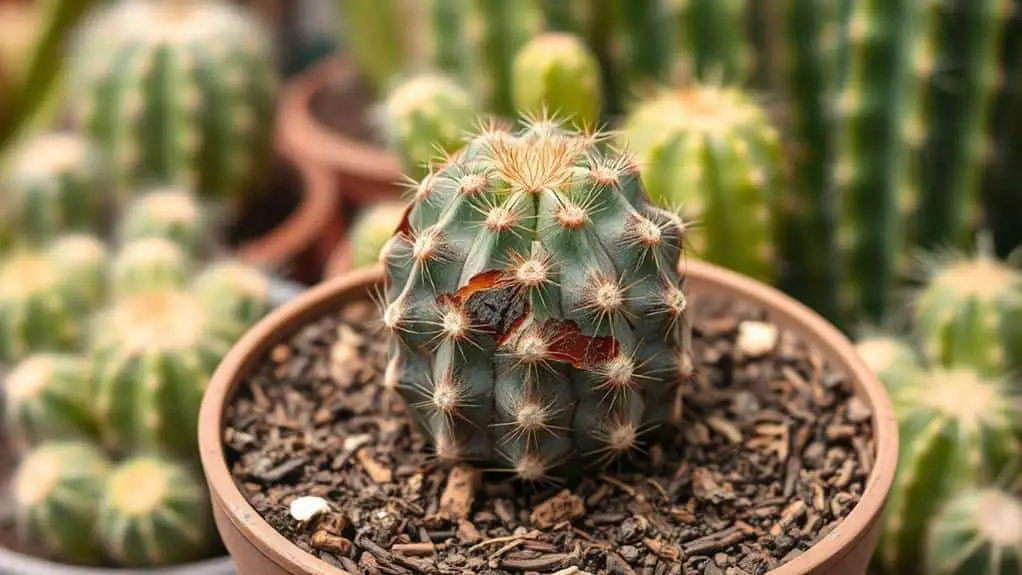
When your cactus starts turning brown, checking the soil quality is essential.
Confirm you're using specialized cactus potting soil because it provides the right drainage and aeration to prevent root rot.
Regularly assess the moisture content and soil composition to guarantee your cactus stays healthy and vibrant.
Drainage and Aeration Importance
Proper drainage and aeration are essential for maintaining a healthy cactus, as these plants are highly susceptible to root rot caused by excess moisture. Without good drainage, water can accumulate around the roots, leading to rot and browning. To guarantee your cactus thrives, you need to focus on creating the right soil environment.
First, use specialized potting soil designed for cacti. This type of soil enhances aeration, allowing air to reach the roots and preventing fungal diseases. Consider the soil composition. It should include ingredients like sand or perlite, which improve drainage and prevent water retention.
Regularly inspecting the soil for compaction or poor aeration is also important. When the soil becomes compacted, it restricts air flow to the roots, causing stress and potential browning.
Here are some practical tips to help:
- Use cactus-specific potting soil
- Add sand or perlite to your soil mix
- Regularly check for soil compaction
- Repot cacti every few years with fresh soil
- Confirm pots have drainage holes
Moisture Content Assessment
Understanding the moisture content of your cactus's soil is fundamental for its health and longevity. Regularly evaluating the soil's moisture helps prevent common issues like overwatering and root rot. A good rule of thumb is to let the soil dry out about 4-5 cm deep before watering again. This keeps your cactus from sitting in too much water, which can cause browning and black spots.
Using specialized potting soil for cacti is another significant step. This type of soil guarantees proper drainage and aeration, reducing the risk of moisture retention. If you notice black spots on your cactus, it could mean there's too much moisture or poor drainage in the soil. Addressing this quickly can prevent further damage.
When you repot your cactus, always check the soil's moisture levels. Replace any soil that looks poor in quality. Regular inspections are important. If the soil is compacted and lacks good aeration, your cactus might turn brown and become diseased.
Maintaining a well-draining environment is essential for your cactus's vitality. By paying close attention to the moisture content, you're giving your cactus the best chance to thrive.
Soil Composition Check
Checking the soil composition is vital for guaranteeing your cactus stays healthy and vibrant. Poor soil can be a major reason why your cactus is turning brown. Specialized potting soil designed for cacti is significant because it guarantees proper drainage and aeration, minimizing the risk of root rot and browning.
If you notice black spots on your cactus, it might be due to excess moisture retention and inadequate drainage caused by poor soil composition.
When doing a soil composition check, keep an eye out for the following:
- Components like sand, perlite, and peat: These promote healthy growth by guaranteeing good drainage.
- Moisture content: The soil should be slightly moist but not waterlogged. Overly moist soil can lead to browning.
- Soil structure: It should be loose and crumbly, not compacted.
- Pot with drainage holes: This is vital to prevent water from accumulating at the bottom.
- Regular assessment: Check the soil condition regularly to confirm it remains suitable for your cactus.
When repotting, always use a well-draining potting soil mix. Taking these steps will help keep your cactus healthy and vibrant, preventing those dreaded brown spots.
Physical Damage

Accidents or mishandling can cause your cactus to turn brown, signaling physical damage. Such damage often appears as brown spots on the surface of your cactus. This can happen if your cactus is accidentally knocked over, mishandled, or comes into contact with sharp tools. When you see these brown spots, it's important to act quickly to prevent further issues.
First, assess your cactus for any visible injuries. Check if the brown areas are soft; this may indicate rot setting in. If you find soft, brown spots, you'll need to carefully cut away the damaged tissue to stop the rot from spreading. Use a clean, sharp knife to make precise cuts, removing all the affected parts.
To prevent future physical damage, guarantee your cactus is placed in a stable location where it won't get knocked over easily. Keep it out of high-traffic areas and away from the edge of shelves or tables.
Handle your cactus with care, especially when repotting or moving it. By taking these precautions, you can protect your cactus from physical damage, helping it stay healthy and green.
Fungal Diseases
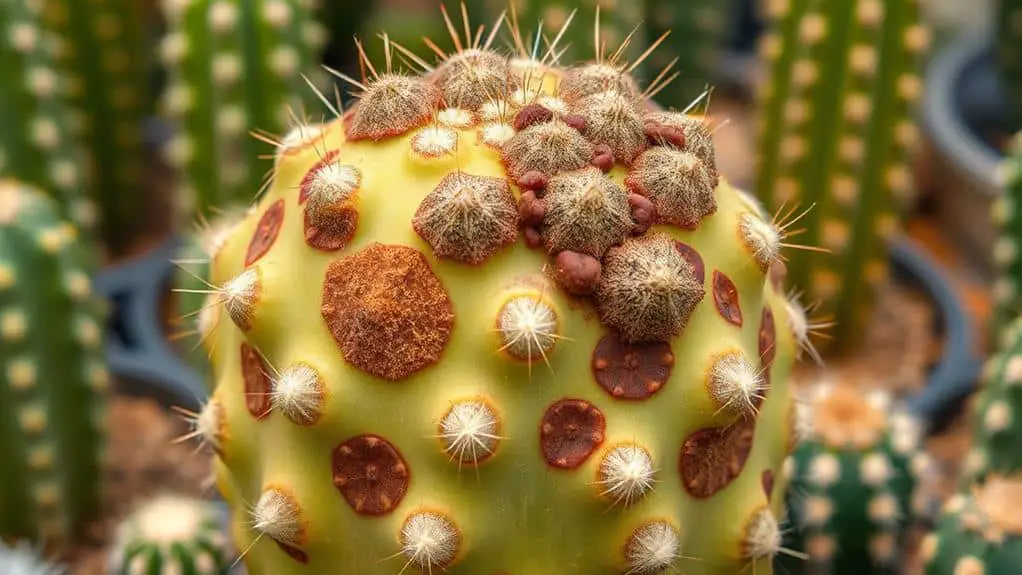
While physical damage is a common reason for browning, fungal diseases can also be a significant threat to your cactus.
These diseases often show up as brown or black spots on the stem, signaling tissue decay and potential rot. Fungal infections like rust and powdery mildew thrive in overly humid conditions or where there's poor air circulation. If not addressed quickly, they can cause serious damage.
To manage and prevent fungal diseases, consider the following steps:
- Use fungicides or carefully remove infected tissue to stop the spread.
- Consistently monitor your cactus for any signs of fungus.
- Make sure your cactus has well-draining soil to avoid water buildup.
- Avoid overcrowding your plants to allow for better air circulation.
- Provide adequate light to reduce humidity around your cactus.
Aging Process
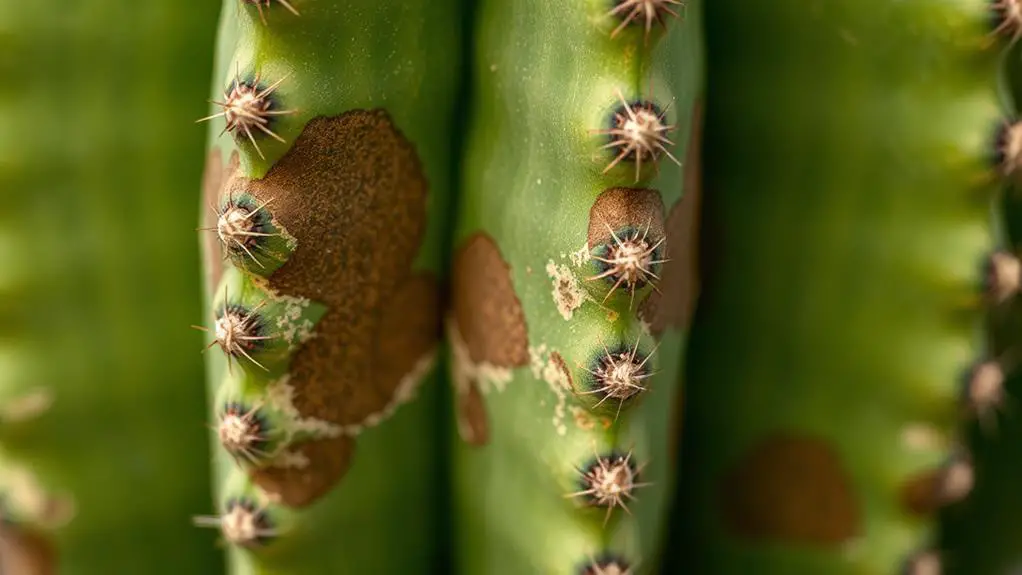
As your cactus matures, you might notice it starting to turn brown at the base, which is often a natural part of the aging process called corking. Corking typically begins low on the cactus and can move upwards over time.
While it might look concerning, this change is normal and expected as your cactus gets older. The areas affected by corking will feel firm and take on a woody texture. This is a sign of stability and strength in mature cacti.
Unlike browning caused by stress or disease, corking doesn't mean your cactus is unhealthy. It's just a cosmetic change that shows your plant is aging.
Don't worry if the discoloration affects how your cactus looks. Corking is irreversible but harmless. It's a natural part of the cactus's life cycle.
If you want to maintain the beauty of your plant, you can propagate healthy sections of the cactus. This allows you to grow new cacti from the old ones, keeping your garden vibrant.
Sunburn

Sunburn can be a silent enemy of your cactus, causing unsightly yellowing and brown scorch marks on its stems. When your cactus is suddenly exposed to intense sunlight, it can suffer from sunburn. This often happens when you move it from a shaded spot to a sunny location too quickly.
To prevent sunburn, remember these tips:
- Gradually increase sunlight exposure over several days.
- Limit direct sunlight to about 5-6 hours per day.
- Use shade cloth to filter intense light.
- Relocate your cactus to a shaded area if you notice early signs of sunburn like yellowing.
- Regularly monitor your cactus for any changes in color or texture.
Sunburn damage can appear as brown, black, or tan patches. The severity of these discolorations depends on how intense and how long the cactus was exposed to the sun.
If you notice these signs, act quickly by moving your cactus to a less sunny spot or using shade cloth to protect it. This will help your cactus recover and prevent further damage.
Pest Infestation
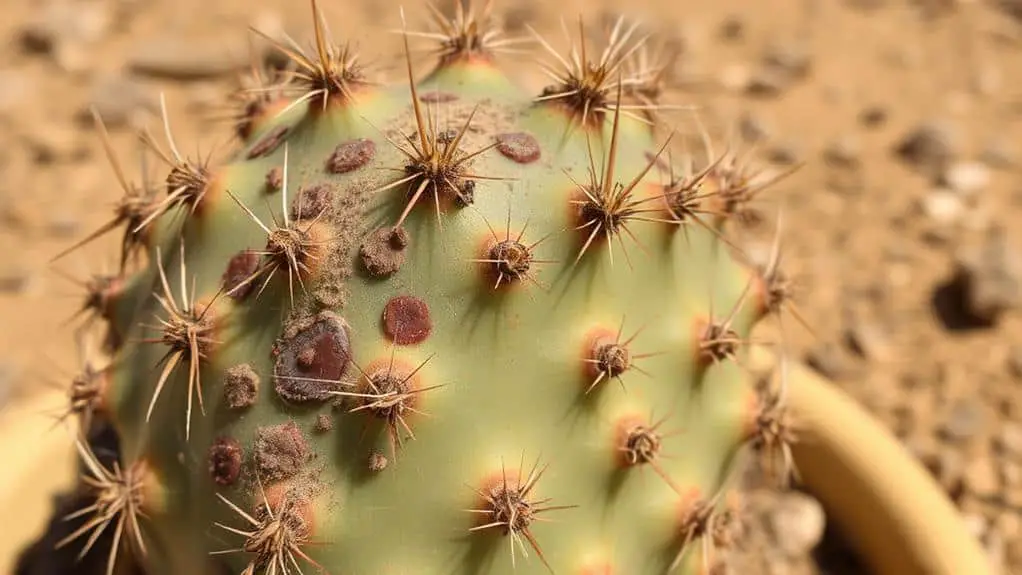
Pest infestations can be a major reason your cactus is turning brown.
Common pests like mealybugs, scale insects, and spider mites suck the plant's sap, weakening its tissue and causing discoloration.
Regularly inspecting your cactus and using treatments like water sprays or horticultural oil can help keep these pests at bay and your cactus healthy.
Common Cactus Pests
When your cactus starts turning brown, one likely culprit is a pest infestation. These pesky invaders can cause discoloration and weaken your plant by sucking its juices. It's important to recognize the common pests that might be affecting your cactus.
Here are some typical pests and what to look for:
- Mealybugs: These appear as white, cotton-like masses. You might spot them on the cactus surface.
- Scale insects: They resemble small brown or black spots on a cactus, often causing the plant's skin to discolor.
- Spider mites: These tiny pests thrive in hot, dry conditions, leaving brown spots and webbing on the plant.
- Aphids: Small, green or black insects that cluster on new growth, causing deformities and discoloration.
- Fungus gnats: While less common, their larvae can damage roots, leading to brown patches.
Regular inspections are key. Look for signs like discoloration, spots, or webbing. Early detection can save your cactus from severe damage.
If you notice any unusual changes, act quickly. Being proactive helps keep your cactus healthy and thriving.
Effective Treatment Methods
Dealing with a pest infestation on your cactus can feel challenging, but effective treatment methods can restore your plant's health. Regularly inspect your cactus for signs of pests like mealybugs and scale insects. These pests often show up as brown spots or sticky residue on your cactus, which can cause it to start turning brown.
If you find scales, gently scrape them off with a soft cloth or use a cotton swab dipped in horticultural oil. This method helps eliminate them without harming your cactus.
For mealybug infestations, mix a solution of water and a few drops of mild dish soap. Spray the affected areas thoroughly, making sure to cover both the top and underside of the cactus.
In cases of severe infestations, apply neem oil or insecticidal soap. Follow the manufacturer's instructions for the correct dosage and how often to apply it.
To prevent future pest problems, keep your cactus in a dry environment with good air circulation. Many pests thrive in high humidity, so maintaining a dry atmosphere can help keep them at bay.
Root Rot

Overwatering is the primary culprit behind root rot in cacti, leading to excessive moisture that damages the roots and causes brown discoloration at the base of your plant.
When a cactus gets too much water, its roots can't breathe, and they start to rot. This puts your cactus at serious risk of root rot.
You'll need to watch for these symptoms:
- Soft, mushy texture in the stems
- Yellowing of the cactus
- Brown spots at the base
- Unpleasant smell from the soil
- Slowed or stunted growth
If you notice any of these signs, it's vital to act fast. First, stop watering your cactus immediately. Let the soil dry out completely.
Then, gently remove the cactus from its pot and check the roots. Healthy roots are white or light tan, while rotting roots will be black or brown and mushy.
To treat root rot, trim away the affected areas, cutting slightly into healthy tissue to guarantee all the rot is gone.
Repot the cactus in fresh, well-draining soil. Early detection is key. Regularly monitor your cactus for any changes and adjust your watering habits to keep your cactus healthy and happy.
Preventive Measures
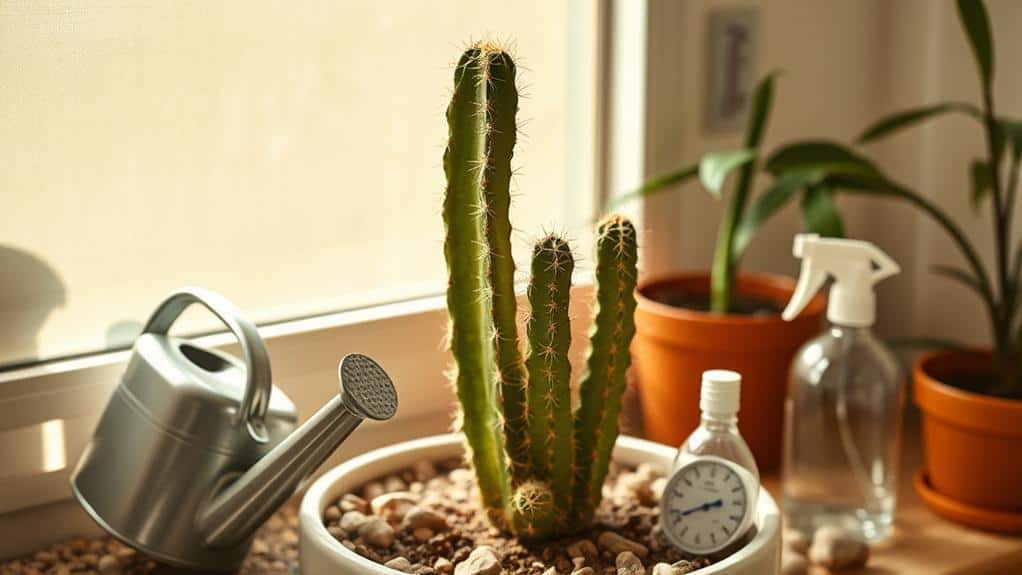
To keep your cactus healthy and green, start by regularly checking your watering habits.
Make sure the soil dries out completely between waterings to avoid root rot.
Also, give your cactus plenty of indirect sunlight and keep an eye out for pests like mealybugs.
Proper Watering Practices
When it comes to keeping your cactus healthy and vibrant, mastering proper watering practices is vital. One key to success is understanding the right watering frequency. Desert cacti thrive when watered less frequently but thoroughly. Always allow the soil to dry out completely at a depth of 4-5 cm before your next watering to prevent root rot.
To guarantee deep absorption, use the capillary method by soaking the soil from the bottom. This way, you won't wet the plant's stem, which can cause browning.
It's also important to adjust your watering frequency based on the seasons. In summer, when your cactus is growing, it needs more water. During its winter dormancy, minimal water is necessary.
Here are some tips to help you master cactus watering practices:
- Use well-draining soil, specifically formulated for cacti.
- Always check the moisture content of the soil before watering.
- Water your cactus thoroughly, but infrequently.
- Avoid getting water on the cactus stem.
- Monitor your cactus regularly to catch early signs of overwatering or dehydration.
Optimal Light Conditions
Ensuring your cactus gets the right amount of light is essential for its health and vibrancy. Cacti thrive in bright, indirect sunlight but can handle around 5-6 hours of direct sunlight daily. To avoid sun spots, gradually acclimate your cactus to stronger light, preventing sudden changes that might cause sunburn and brown patches.
If you notice browning, try relocating your cactus to a spot with filtered light or partial shade. For indoor cacti, placing them near south or west-facing windows is ideal since these areas provide ample light without overheating risks. Reflective surfaces or grow lights can also help if natural light is scarce, mimicking the desert conditions cacti love.
Here's a quick guide to help you:
| Light Condition | Sun Exposure Time | Action Needed |
|---|---|---|
| Bright, Indirect Light | All day | Ideal for most cacti |
| Direct Sunlight | 5-6 hours | Gradually acclimate |
| Shady Area | Minimal | Move to brighter spot slowly |
| Filtered Light | Variable | Good for browning recovery |
| Artificial Light | 10-12 hours | Use grow lights if needed |
Pest and Disease Monitoring**
Keeping a close eye on your cactus can make a world of difference in its overall health. Regularly inspecting for pests and diseases is essential. Pests like mealybugs and scale insects can cause browning by sucking the plant's juices.
Fungal diseases, marked by discoloration or black spots, are also common, especially in outdoor plants. Early detection can prevent severe damage.
To help you stay on top of things, consider these practical steps:
- Inspect your cactus: Check for pests and symptoms of fungal diseases every few weeks.
- Treat minor infestations promptly: Use horticultural oil or insecticidal soap directly on affected areas.
- Promote good air circulation: This helps reduce humidity and discourages fungal infections.
- Establish a monitoring routine: Regular checks during the growing season are particularly important.
- Act quickly: Early intervention can save your cactus from further harm.
Frequently Asked Questions
How Do You Save a Browning Cactus?
To save a browning cactus, stop watering it immediately. Cut away soft, brown tissue with a sterile knife. Transplant into well-draining soil. Monitor for new growth and adjust care seasonally. Treat pests or diseases with appropriate solutions.
What Does an Overwatered Cactus Look Like?
An overwatered cactus looks brown at the base, feels mushy, and may have yellowing stems or droopiness. You might also notice black spots and weeds around it. Stop watering and repot in well-draining soil immediately.
What Does It Mean When My Cactus Is Brown?
When your cactus turns brown, it's often due to overwatering, leading to root rot, or sudden sun exposure causing sunburn. It might also signify natural aging, fungal infections, pest infestations, or environmental stressors like poor drainage.
How Often Should You Water a Cactus?
You should water your cactus every 2-4 weeks during spring and summer. In winter, water less frequently. Always let the soil dry 4-5 cm deep between waterings to prevent root rot. Adjust for temperature and sunlight exposure.
Conclusion
Don't worry if your cactus is turning brown; you can fix it! Check your watering habits, make sure it gets enough light, and inspect for pests or diseases. Adjusting these factors can really help. Remember, it might just be natural aging, so don't panic. With some attention and care, your cactus can thrive. Keep an eye on it, and you'll see improvements in no time. Happy gardening, and stay confident in your green thumb!

